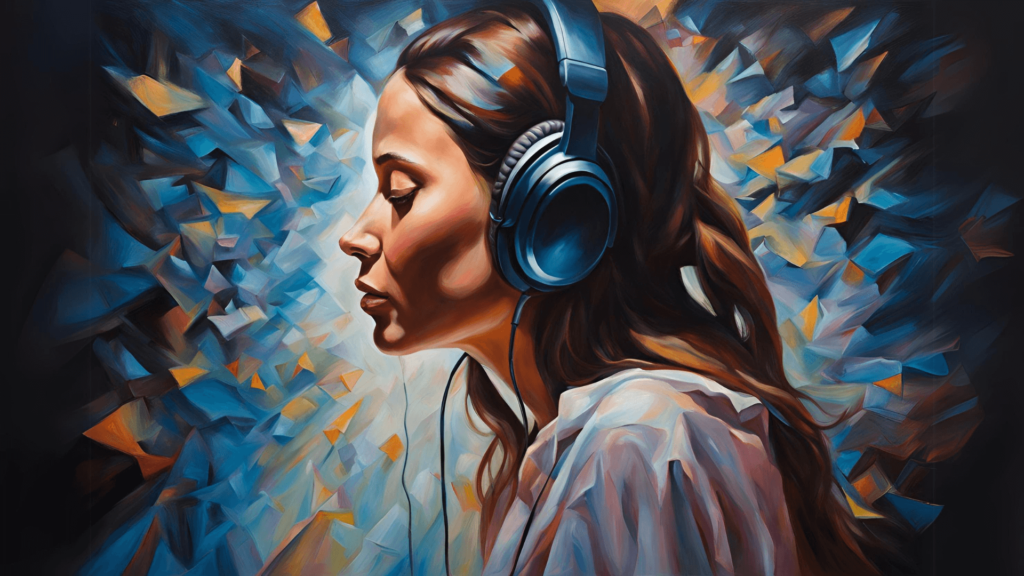In this post I want to share a method that I’ve found helpful for connecting more deeply with a song. This is one of the listening approaches I use after I’ve noticed an initial pull with a song and I’ve placed it in a general “pulls” playlist along with other songs that have drawn me (for more on this, see the expressive playlisting process)
Step 1: Use Your Body to Synchronize with the Song
I listen with over-the-ear headphones and close my eyes for full immersion in the music. Once I press play, my initial focus is to try to find the rhythm of the song in my body. Regardless of whether it has a tight, intricate groove or just some flat synth pads droning, I’m trying to express the rhythm using my body.
By that I mean that I try to move my body in a way that mirrors the quality of the rhythm. This can range from small ways, (like a finger movement or a foot tap), to full body movement like swaying.
Attuning
For me this feels like a more exaggerated form of how a good listener might attune to another person in face-to-face conversation when trying to connect with them. You allow your body to be animated by the subtle rhythms of the other as they smile, tighten up, lean forward, fidget, etc., and a kind of mirroring spontaneously arises between you.
There’s a synchronizing going on, and feeling-tones and imagery can arise in the background of your awareness as you do this. Psychotherapists are trained to notice these sorts of internal reactions when attuning to a new client—the images and feelings that arise in the presence of another person can be useful information if you practice listening for it. Imagine doing this with a song rather than a person and you’ll have the feel for the first step of this process. It’s about connecting with the song on a bodily level and allowing it to animate your movement in subtle ways.
Step 2: Carry This Over into Imagination
Next, I extend this synchronizing movement from my physical body to my imagined body (closing my eyes makes it easier to go inward). With my physical body, I can’t get up and do a pirouette, but in my imagination I can. So, if the song inspires this movement, I do it in my imagination. Now I’m moving with the song on another level, without the constraints of the body. In my mind’s eye, I can do anything: I can move arms made of rubber rather than muscle and bones, I can tower over a city and stomp like a giant, I can rise up into the sky and pierce the clouds.
I’m allowing the song to animate my imagination as well as my physical body. Sometimes I even reduce the activity of my body to maybe just a subtle sway, while the bulk of the “movement” is done through visualization. You could think of this step as dancing with the song in your imagination. You’re allowing it to influence your visualizing process.
Staying Present
One of the most important aspects of the practice above (maybe the most important) is that it helps you stay in touch with the music as its unfolding. I’ve found that the biggest obstacle to connecting with a song is my tendency to slip into evaluation mode prematurely. And the presence of evaluations is a tip-off that I’m in my head, thinking, not in the present moment and flowing with what I’m experiencing.
Making the goal to stay in rhythmic attunement with the song—rather than to form a judgment of it—helps me stay present and connected to what’s unfolding. Formulating it as a goal (“move with the song in imagination”) gives my mind something to focus on so that it doesn’t get in the way of the connecting process. If I’ve stopped visualizing with the song, I know I’m no longer in the present moment and I come back to it. The anchor of the moving body can be helpful here. Have I gone still? Am I up in my head? Let’s start moving the body again. Then extend it into imagination. And then I’m back on track.
Connection
The approach described above has been helpful for getting to a receptive space where I can be touched by the song. With songs I end up liking, something in the song almost seems to “come out and meet me” during this process. And imagination (permeated by feeling and grounded in the body) seems to be the medium in which this contact occurs for me. But it requires being in the moment and in flowing contact with the song, which means suspending any thinking about the song. When I notice I have slipped into thinking, I ask the question “am I moving with this song?” which helps reorient me to my goal of staying in sync with the song using my body and imagination.
A Condensed Version of this Exercise
After using this approach for a while, I’ve condensed it to simply closing my eyes and allowing an image to form of the rhythm of the song itself. I’ve found that different rhythms evoke different imagery within me. Here are some examples of what I mean.
When I close my eyes and allow the song “All Over the House” by Devontée to animate my imagination, I see some kind of giant machine rolling through a post-apocalyptic landscape:
And with Upsahl’s song Kickflip, I see an image from an old-fashioned cartoon, in which a dancing figure is cut in half at the midsection, such that their upper body is going one direction and the lower half is going in the opposite direction. I also picture that BB-8 robot from Star Wars: The Force Awakens with his distinct style of movement. There’s a bobbing and rolling, like a buoy on the waves—stable and unstable at once:
So now my first goal when listening to a song is to try to connect with it on a rhythmic level through the practices above: I synchronize my bodily movement with the song in some way, I allow it to animate my imagination and I notice the imagery that arises with the rhythm. This brings me into the song (and out of my head), which enables it to contact me on levels I’d be blocked from otherwise.
Once I do this, new imagery and feeling-tones often emerge from the song as it unfolds. I’ve found that not only the groove, but the shape of the arrangement as it develops in time (with contoured dynamics like expansion and contraction as it goes from verse to chorus and back) will also activate imagery, as will the surface qualities of the sound-design itself (often with a more tactile quality like thick and chewy or thin and crispy, etc.). Certain devices in songs, like modulation between keys, tends to produce strong, emotionally-charged imagery in me.
I’ve noticed that whether a song produces this kind of imagery in me tends to be a marker of whether I will ultimately like it or not. Songs where very little, or no, imagery occurs seem to be those I lack an ear for. With no imagery there is also little feeling and I find it hard to connect.
But in order to contact any of this, I need to find my way into the song first, which means suspending judgement and entering into resonance with it on a bodily and then imaginal level. For me, starting with the rhythm is an effective way in.
How about you: do you have any ways of listening that help you reliably get out your head and into the song?
Last Updated on November 30, 2024

